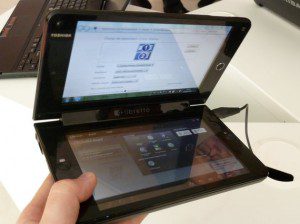We discussed the Apple iPad a couple of months ago as the product that could transform expectations of the tablet/portable/cloud computing world. Well, eighty days into the product launch, and 3 million iPads later, the market is soon to get another competitor: the Toshiba Libretto. Neither is/will be the first into the market, but Apple’s iPad has proven itself the game-changer many expected. What are some of the early reports on the Libretto?

The dual-screen Libretto W100
The product will not be on general sale until ‘later in the summer,’ but tech sites have been able to get models for review. PCWorld.com proffers a largely positive review of the new machine, especially its dual yet discrete screens: “It has two 7-inch diagonal touchscreens (1024 by 600 resolution), which means you can run separate apps on each screen and drag and drop information, icons, and images back and forth between the dual screens. You can use this system as tablet or a notebook, which means you can draw or take notes as well.” PCWorld (and note the title) concludes that the running of Windows on the machine makes it an ideal micro-computer for the business world: “If you’re using Windows, this little gadget seems to have it all. Its seamless synchronization is another big plus for users such as sales staff, field technicians, and other offsite workers that must integrate all their data into a larger system on a network or onto a company server.”
The BBC’s Rory Cellon-Jones accredits Toshiba with inventing the micro/tablet computer over fifteen years ago, but he is rather sanguine about how much the company has learned from recent developments, especially those driven by Apple:
The truth is that the device, like so many tablets that came along before Apple transformed the market, just isn’t good enough. It’s hard to use – I found myself jabbing at the screen with increasing frustration – harder to navigate, and its design already looks a little dated. But even if it isn’t beautiful perhaps it is more functional than Apple’s shiny plaything? I tried a simple test, updating my Facebook status with each machine. It took me five minutes on the Toshiba – and my status update was so full of typos as to be virtually unreadable. The same task carried out on an iPad took half as long, despite having to reset my wireless connection halfway through, and produced a readable result.
Finally (for today), Endgadget.com admitted to a number of limitations, but pointed out that theirs is an early prototype. Toshiba will surely polish a number of rough (software) edges by the time of its release – though Endgadget stressed the relative limitations of said release: “We’re sure the final product will be much more polished for its $1k+ price tag, but Toshiba’s certainly stressing that this device will be a very limited run and is meant for “early adopters.” So then, early adopters, we ask you: are you going to pick up one of the first dualscreen tablets to grace our fine universe? ”
Though more expensive than the iPad, and apparently admitting to limited success at the outset, the Libretto W100 suggests a new design from which companies can launch still more hand-held computers. Think of the distinctions among bar-of-soap cellular phones (iPhone, early Nokia sets) and clamshells or slide-reveal phones. Toshiba has offered a different way to access screen(s) and keyboards, which might inspire still further innovation. Whichever developments take the lead in the market, the fact of the micro computer and its access to network communications will continue to adjust our perceptions of computers as tools to access our own harddrives. We will continue to expect our software and our media to be in the ‘computing cloud’ and accessible by ever smaller and quicker machines.
